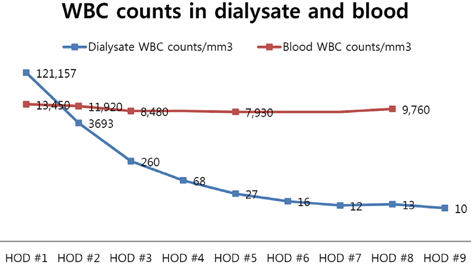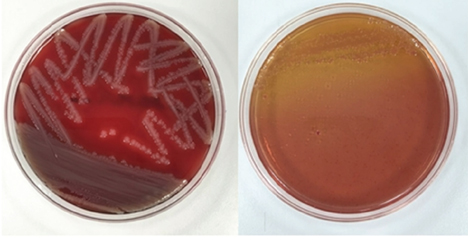Electrolyte Blood Press.
2018 Dec;16(2):27-29. 10.5049/EBP.2018.16.2.27.
A Case of Peritoneal Dialysis-related Peritonitis Caused by Aeromonas Hydrophila in the Patient Receiving Automated Peritoneal Dialysis
- Affiliations
-
- 1Internal Medicine, Veterans Healthcare System Medical Center, Seoul, Korea. biizz@hanmail.net
- 2Department of Laboratory Medicine, Veterans Healthcare System Medical Center, Seoul, Korea.
- KMID: 2439089
- DOI: http://doi.org/10.5049/EBP.2018.16.2.27
Abstract
- Peritoneal dialysis (PD)-related peritonitis is a major cause of injury and technique failure in patients undergoing PD. Aeromonas hydrophila is ubiquitous in the environment, and is a Gram-negative rod associated with infections in fish and amphibians in most cases; however, it can also cause opportunistic infections in immunocompromised patients. We report a case of A. hydrophila peritonitis in a 56-year-old male on automated PD. Peritonitis may have been caused by contamination of the Set Plus, a component of the automated peritoneal dialysis device. Although Set Plus is disposable, the patient reused the product by cleansing with tap water. He was successfully treated with intraperitoneally-administered ceftazidime and has been well without recurrence for more than 2 years.
MeSH Terms
Figure
Reference
-
1. Piraino B, Bernardini J, Brown E, Figueiredo A, Johnson DW, Lye WC, et al. ISPD position statement on reducing the risks of peritoneal dialysis-related in-fections. Perit Dial Int. 2011; 31:614–630.
Article2. Kavanagh D, Prescott GJ, Mactier RA. Peritoneal dialysis-associated peritonitis in Scotland (1999-2002). Nephrol Dial Transplant. 2004; 19:2584–2591.
Article3. Yap DY, Chu WL, Ng F, Yip TP, Lui SL, Lo WK. Risk factors and outcome of contamination in patients on peritoneal dialysis--a single-center experience of 15 years. Perit Dial Int. 2012; 32:612–616.
Article4. Zelenitsky S, Barns L, Findlay I, Alfa M, Ariano R, Fine A, et al. Analysis of microbiological trends in peritoneal dialysis-related peritonitis from 1991 to 1998. Am J Kidney Dis. 2000; 36:1009–1013.
Article5. Ramesh K, Raymond TK. Nolph and gokal's textbook of peritoneal dialysis. 3rd edition. p. 543–547.6. Lee JY, Seo JH, Jin SH, Kwak HK, Park KH, Lee JH. A Case Report of Aeromonas Hydrophila Peritonitis in CAPD Patient. Korean J Nephrol. 2012; Suppl 1. 274.7. Lee WS, Puthucheary SD. Retrospective study of Aeromonas infection in a Malaysian urban area: a 10-year experience. Singapore Med J. 2001; 42:057–060.8. Snower DP, Ruef C, Kuritza AP, Edberg SC. Aeromonas hydrophila infection associated with the use of medicinal leeches. J Clin Microbiol. 1989; 27:1421–1422.
Article9. Davis WA 2nd, Kane JG, Garagusi VF. Human aeromonas infections: a review of the literature and a case report of endocarditis. Medicine (Baltimore). 1978; 57:267–277.10. Janda JM, Abbott SL. The genus Aeromonas: taxonomy, pathogenicity, and infection. Clin Microbiol Rev. 2010; 23:35–73.
Article11. Choi JP, Lee SO, Kwon HH, Kwak YG, Choi SH, Lim SK, et al. Clinical significance of spontaneous Aeromonas bacterial peritonitis in cirrhotic patients: a matched case-control study. Clin Infect Dis. 2008; 47:66–72.
Article12. Heo J, Um SH. Microbiological characteristics of spontaneous bacterial peritonitis in Korea. Korean J Hepatol. 2007; 13:304–308.
Article13. Liakopoulos V, Arampatzis S, Kourti P, Tsolkas T, Zarogiannis S, Eleftheriadis T, et al. Aeromonas hydrophila as a causative organism in peritoneal dialysis-related peritonitis: case report and review of the literature. Clin Nephrol. 2011; 75:Suppl 1. 65–68.14. Chang CF, Chen TL, Chen TW, Yang WC, Lin CC. Recurrent dialysis-associated Aeromonas hydrophila peritonitis: reports of two cases and review of the literature. Perit Dial Int. 2005; 25:496–499.
Article
- Full Text Links
- Actions
-
Cited
- CITED
-
- Close
- Share
- Similar articles
-
- A Rare Cause of Automated Peritoneal Dialysis-Related Peritonitis: Aeromonas caviae
- Peritonitis due to Leclercia adecarboxylata in a Patient Receiving Automated Peritoneal Dialysis
- Peritoneal-pleural leak improved by switching from continuous ambulatory peritoneal dialysis to automated peritoneal dialysis
- A Case Report of Mycobacterium abscessus Peritonitis in a Patient on Continuous Ambulatory Peritoneal Dialysis
- A Case of Continuous Ambulatory Peritoneal Dialysis Related Peritonitis Caused by Ochrobactrum anthropi



